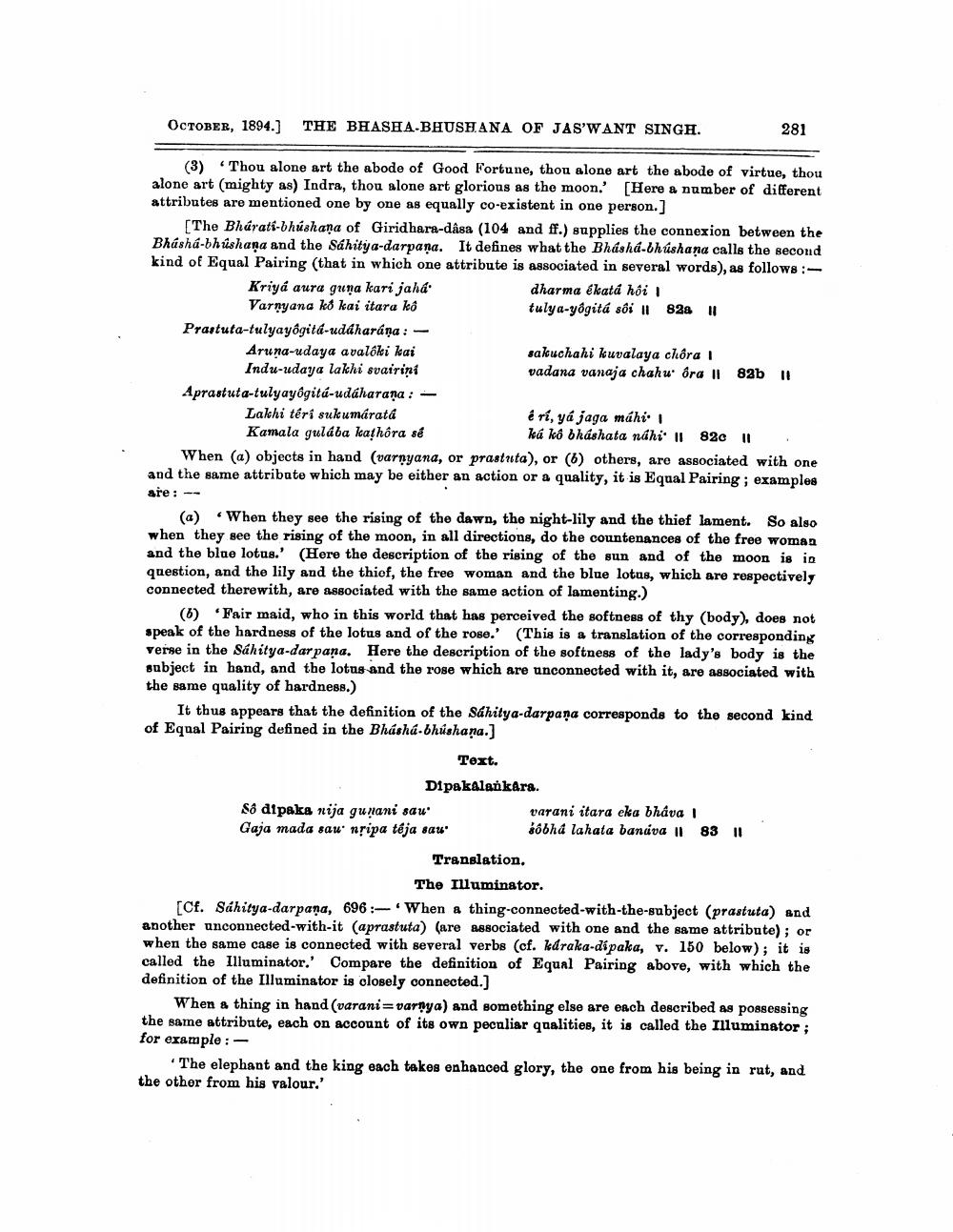________________
OCTOBER, 1894.] THE BHASHA-BHUSHANA OF JAS'WANT SINGH.
(3) Thou alone art the abode of Good Fortune, thou alone art the abode of virtue, thou alone art (mighty as) Indra, thou alone art glorious as the moon.' [Here a number of different attributes are mentioned one by one as equally co-existent in one person.]
[The Bharati-bhúshana of Giridhara-dâsa (104 and ff.) supplies the connexion between the Bhasha-bhushana and the Sahitya-darpana. It defines what the Bháshá-bhúshana calls the second kind of Equal Pairing (that in which one attribute is associated in several words), as follows:
dharma élatả hội tulya-yogita sôi || 828 ||
Kriyá aura guna kari jahá' Varnyana ko kai itara kô
Prastuta-tulyayogitá-udaharana: -
Aruna-udaya avalôki kai Indu-udaya lakhi svairint
Aprastuta-tulyayogitá-udaharana :
Lakhi téri sukumáratá Kamala gulába kaṭhôra sé
sakuchahi kuvalaya chôra
vadana vanaja chahu ora 11 82b I
é rí, ya jaga mahi |
ká kô bháshata nahi || 820 ||
281
When (a) objects in hand (varnyana, or prastuta), or (b) others, are associated with one and the same attribute which may be either an action or a quality, it is Equal Pairing; examples
are: --
(a) When they see the rising of the dawn, the night-lily and the thief lament. So also when they see the rising of the moon, in all directions, do the countenances of the free woman and the blue lotus.' (Here the description of the rising of the sun and of the moon is in question, and the lily and the thief, the free woman and the blue lotus, which are respectively connected therewith, are associated with the same action of lamenting.)
(6) Fair maid, who in this world that has perceived the softness of thy (body), does not speak of the hardness of the lotus and of the rose.' (This is a translation of the corresponding verse in the Sahitya-darpana. Here the description of the softness of the lady's body is the subject in hand, and the lotus and the rose which are unconnected with it, are associated with the same quality of hardness.)
Sô dipaka nija gunani sau Gaja mada sau nṛipa téja sau
It thus appears that the definition of the Sahitya-darpana corresponds to the second kind of Equal Pairing defined in the Bhasha-bhúshana.]
Text. Dipakalankara.
varani itara eka bhava | sôbha lahata banáva || 83 ||
Translation.
The Illuminator.
"
[Cf. Sahitya-darpana, 696: When a thing-connected-with-the-subject (prastuta) and another unconnected-with-it (aprastuta) (are associated with one and the same attribute); or when the same case is connected with several verbs (cf. karaka-dipaka, v. 150 below); it is called the Illuminator.' Compare the definition of Equal Pairing above, with which the definition of the Illuminator is closely connected.]
When a thing in hand (varani varnya) and something else are each described as possessing the same attribute, each on account of its own peculiar qualities, it is called the Illuminator; for example: -
The elephant and the king each takes enhanced glory, the one from his being in rut, and the other from his valour.'




